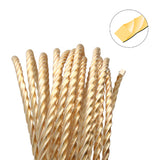Which Wire When?
We have had a lot of questions about beading wire. Many more beaders are shopping online and realising there is a lot more choice when buying beading wire than is available in most craft shops. So here it is, an explanation and guide to beading wires!!!

What is beading wire?
Beading wire is a stringing material typically made of a base or precious metal and coated in transparent nylon to prevent tarnishing. It comes in a HUGE variety of finishes, including Sterling Silver, Brass, Steel, Copper, Bronze, Gold Plate, Silver Plate…and on and on. The latest craze is using coloured coated wire to let the wire itself be a feature of the piece. The Beading Room will soon be stocking pinks, purples, blues, greens, yellow, red, and more!

Why use beading wire?
Well beading wire is lightweight and so strong in comparison to other stringing materials. It withstands abrasion, tarnishing and stretching. It comes in a wide variety of colours (as above), widths, strengths, and has different levels of flexibility. Some of our beading wires are even ‘knotable’! It is easy to thread on beads as its rigidity means you do not need a needle and the end does not fray like with thread and cord. You can use a thin wire for a ‘barely there’ look but still have all the strength needed for a longlasting piece of jewelry.

What do ‘Strands’ mean?
Beading wire is usually categorised by the number of ‘strands’ it has. The more strands, the more flexibility the wire has (and the more expensive it is too!). The ‘wire’ is actually more than one wire-it consists of small strands which are twisted together before they are coated in nylon. So the more strands the wire is composed of, the more movement it has. The Beading Room sells the Flexrite brand (for The Beadsmith), which in our opinion is the best quality and value of the leading brands. It comes in 7, 14, 21, 28 and 49 strand qualities, availability depending on the finish. The term ‘tigertail’ normally refers to the economical 7 strand variety. 49 strand is used for a superior finish. But, depending on your design, 49 strand may not suit your needs. If you want a more rigid and sculptural look, use a lower strand variety. If you want something to drape naturally, as a fabric thread would, use a higher strand variety.

What about thicknesses?
The diameter of wire you need depends on two factors-the weight of beads you are using and the diameter of the bead holes. Our wire comes in sizes such as .012″ up to .024″. Look at your beads, feel your beads. Do you want a more substantial diameter of wire, or are you using dainty, small beads which require a wire in better proportion? It is a difficult area to advise-beaders just have a sense of how they want their pieces to look and feel, and tend to have a variety of thickness on hand.
Is there anything else to consider when purchasing wire?
Make sure to purchase crimps that are appropriate to the size of your wire, as well as French Wire and/or Wire Guardians if you are wanting that complete look. You want to give your pieces a professional finish, and using the correct findings is key. Look on the spool of your wire, find the diameter and use this number when purchasing your crimps and wire guardians. It is also worth having a variety on hand-you may choose to make a multistrand piece where you will be putting more than one diameter of wire through the guardian and/or crimp.
If you have any questions or comments regarding this blog, please feel free to post it or contact us via the website. We are more than happy to help:)
(Originally published September 28, 2009)
